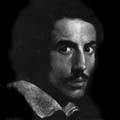
GIOVANNI
LORENZO BERNINI was, in the assessment of Janson (History of Art,
p. 410), the greatest sculptor-architect of the 17th century. He began
his career as a student of his father Pietro Bernini (1582-1629), a
sculptor who had himself worked at one time with Camillo
Mariani.
Later
he attracted the patronage of Cardinal Maffeo Barberini, for whom he
designed a palace. When Barberini was subsequently installed as Pope
Urban VIII, 1623, Bernini was put in charge of building operations at
St. Peter's Basilica at the Vatican, where one of his early works, 1624-33,
was the canopy [baldachin] over the high altar. He also created, 1657-66,
the soaring marble, gilded bronze and stucco Chair of St. Peter [Cathedra
Petri] for the Basilica.
Bernini's
baroque style was a powerful influence on the architecture of his period.
His most famous architectural works are the symmetrical curved colonnades
of St. Peter's, the facade of Barberini's palace, and the arsenal at
Civita Vecchia. Late in his career Bernini designed a series of three
churches, culminating in the domed Sant' Andrea al Quirinale, 1658-70,
in Rome.
In
sculpture, Bernini's masterwork is the Cornaro
Chapel at the Church of S. Maria della Vittoria in Rome, commissioned
by Cardinal Patriarch Federico Cornaro (G-17).
The centerpiece is The Ecstasy of S. Teresa of Avila, a large
statue designed to be illuminated by reflected light from a hidden window.
The figures of S. Teresa and an angel are seen upon a stage, witnessed
by seven Cardinals and a Doge of the Cornaro family looking on from
flanking balconies. The Fountain of the Four Rivers, 1648-51, in Piazza
Navona is another of his celebrated sculptural groups.


